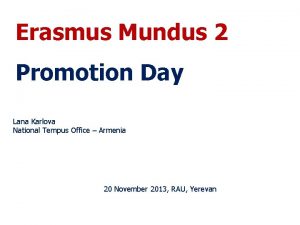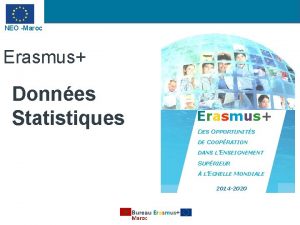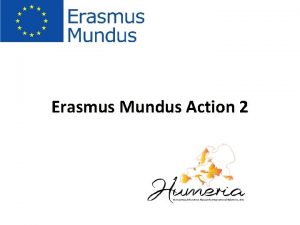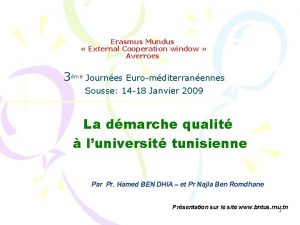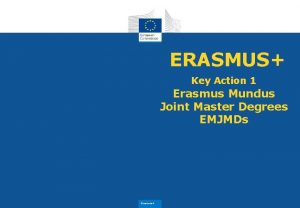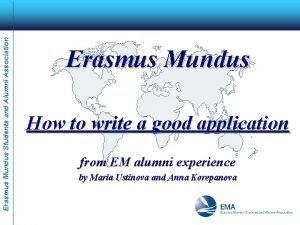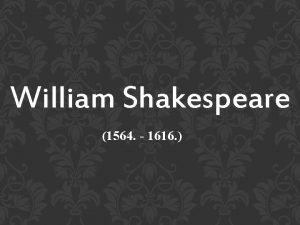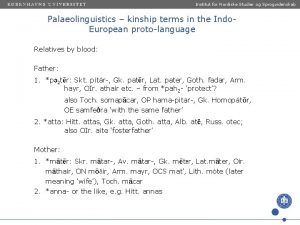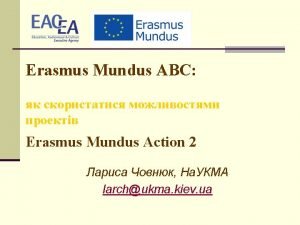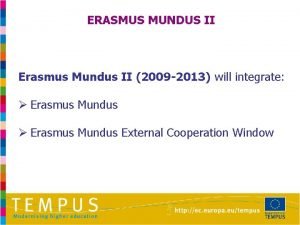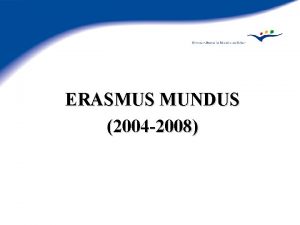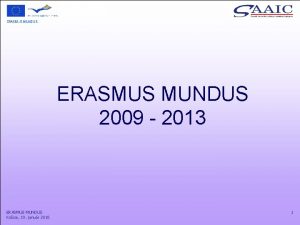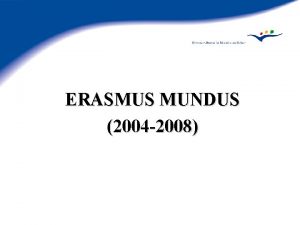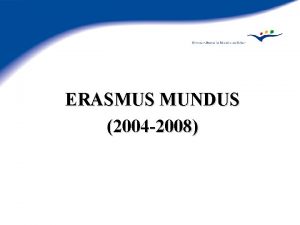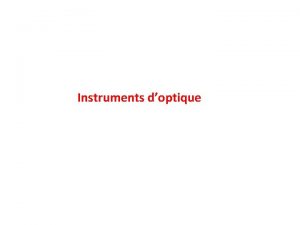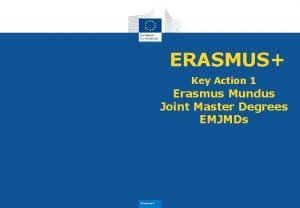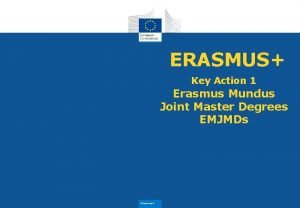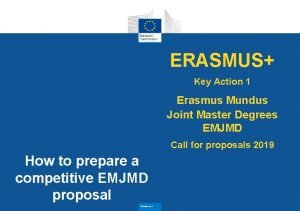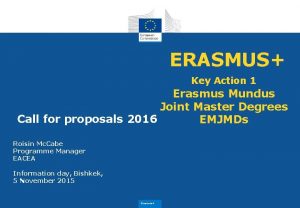Institut dOptique 2 nd Year Master Erasmus Mundus




















- Slides: 20

Institut d’Optique 2 nd Year Master Erasmus Mundus M 1 Principles of lasers François BALEMBOIS Professor at lnstitut d’Optique Office R 1. 7 Phone 01 64 53 34 20 Email : francois. balembois@institutoptique. fr Laser group Laboratoire Charles Fabry, Institut d'Optique

Introduction Outline of this introduction : - Basic principles of lasers - Historical Background - Properties - Outline of the laser course and relationship with other courses 2

Matter-light interaction 3 main processes : absorption E 2 DE = h n Spontaneous emission photon Stimulated emission E 1 photon atom Upward transition and absorption Spontaneous downward transition and emission Stimulated downward transition and emission of identical photon E 2 - E 1 = hn = photon energy 3

The LASER effect Light Amplification by Stimulated Emission of Radiation (acronym) photon All the emitted photons are similar Same direction Very small divergence Same wavelength Monochromatic light (l = hc/DE) Same phase Coherent beam (temporally and spatially) 4

Conditions for light amplification Stimulated emission is always in competition with absorption Atom 1 Atom 2 Atom 3 N 2>N 1 is required for amplification (population inversion) photon N 2 N 1 Energy However, at thermal equilibrium : E 2 E 1 N 2 N 1 population «Pumping» is necessary 5

Example : optical pumping 1958 : Alfred Kastler demonstrated that population inversion can be achieved with optical absorption (Nobel prize 1962) Example of optical pumping for a « 4 -level » system - Two levels for the «pumping transition» - Two levels for the «laser transition» Fast decay Pumping Energy N 2 N 1 Photon emission Fast decay Level not thermally populated Population inversion 6

Laser oscillator 3 main components The active medium Source of energy amplifies the radiation by stimulated emission mirror Provides energy to the medium For population inversion Active medium The cavity Output beam The Pumping system Confines emitted light And enhances stimulated emission (with respect to spontaneous emission) Alfred Pérot 1863 - 1925 Charles Fabry 1867 - 1945 7

Laser oscillator 3 main components The active medium Source of energy amplifies the radiation by stimulated emission mirror Provides energy to the medium For population inversion Active medium The cavity Output beam The Pumping system Confines emitted light And enhances stimulated emission (with respect to spontaneous emission) Alfred Pérot 1863 - 1925 Charles Fabry 1867 - 1945 8

Historical background From the concepts…. 1887 : Heinrich Hertz discovered the photoelectric effect 1901 : Max Planck established the law of the blackbody radiation 1905 : Albert Einstein postulated that electromagnetic energy is quantified. The concept of «photon» was born Problem of compatibility between the photon and the black body radiation 1913 : Niels Bohr introduced the quantification of the energy levels for electrons 1917 : Albert Einstein introduced the concept of stimulated emission 9

. . . To the first experimental results 1954 : Charles H. Townes and Jim Gordon (Columbia University) realized the first MASER (with ammonia l=13 mm) Microwave Amplification by Stimulated Emission of Radiation 1958 : Alfred Kastler demonstrated first optical pumping 1958 : Charles Townes and Arthur Schalow (Bell Labs) established theory of «optical maser» 10

. . . To the first experimental results 1954 : Charles H. Townes and Jim Gordon (Columbia University) realized the first MASER (with ammonia l=13 mm) Microwave Amplification by Stimulated Emission of Radiation 1958 : Alfred Kastler demonstrated first optical pumping 1958 : Charles Townes and Arthur Schalow (Bell Labs) established theory of «optical maser» 1960 : Ted Maiman (Hughes Research Labs) demonstrated the first laser (ruby laser at 694 nm, Cr 3+: Al 2 O 3) 1961 (MIT) 1961 : First Helium-Neon (l=1, 15 µm) 1962 : First red Helium-Neon (l=632, 8 nm) 1965 : First semiconductor laser 11

The first laser Mirrors Flash lamp (July 8 th 1960, New York Times) 12

Different types of lasers Depending on the active medium : - gas lasers - solid-state lasers - dye lasers - semiconductor lasers Depending on the pumping source : - electrical pumping - optical pumping - chemical pumping 13

Introduction Outline of this introduction : - Basic principles of lasers - Historical Background - Properties - Outline of the laser course and relationship with other courses 14

The Laser : a concentrate of light A spatial concentrate Image diameter on the retina Intensity (W/cm 2) He. Ne 1 m. W à 633 nm 20 µm > 102 Sun 100 µm 10 Helium Neon can damage the retina! - Directivity : l=633 nm ex w 0=1 cm, q =2 10 -5 rad Diametrer is doubling after 500 m! -Tight focusing q 2 w 0 4 w 0 500 m q=l/(pw 0) Smallest diameter about l 2 w 0= l 15

The Laser : a spectral concentrate Very narrow emission band achievable Dn = 10 Hz (down to 1 Hz!) 633 nm corresponds to 474. 1012 Hz (THz) Very large coherence length (Dn = 10 Hz, L=30 000 km = l 2/Dl) Very high spectral density (d. P/dn) Þ excitation of hyperfine atomic transitions achievable 16

The laser : a temporal concentrate - Ultrashort pulses : 4, 5 femtoseconds (4, 5 10 -15 s) in near infrared <100 attoseconds (100 10 -18 s) in the X domain - Ultrahigh peak power Nd: YAG 100 m. J, 5 ns : Ppeak = 20 MW Amplified femtosecond laser 1 J, 20 fs : Ppeak = 50 TW non linear effects in matter Microscope objective Infrared laser 850 nm 10 ps 10 µJ Water cell Spectral continuum 17

Taken from Review and forecast of the laser market (Laser Focus World 2009) The laser marketplace 1995 2000 2010 Telecommunications 14% 48% 31% Data storage 8% 15% 13% Material processing 35% 19% 35% Medical therapeutics 17% 7% 7% Scientific and military 10% 2% 6% Instrumentation, measurements 4% 1% 4% Others 8% Others 4% 8, 0 6, 4 Market ($ billion) Others 10% 1, 25 Laser diodes 18

Outline of the course Chapter I : Atoms and photons Chapter II : Optical amplification Chapter III : Laser oscillator Chapter IV : Pulsed lasers Chapter V : Laser optics 12 lectures of 1 H 30 6 tutorials of 1 H 30 (assistant professor : Yvan Sortais) 19

Connection with other courses Courses (this year) : Laser diodes (G. Lucas-Leclin) Non linear optics (N. Dubreuil) Guided and coupled waves (J-M. Jonathan) Next year : Laser technology (P. Georges) Laser physics (M. Hanna) Lab sessions (this year) - Mounting and characterization of different lasers (Helium-neon, Nd: YAG, laser diodes) - Experiments with lasers (interferometry, telemetry) Next year - Ultrashort pulsed lasers - Lasers and non linear optics 20
 Erasmus mundus joint doctorates
Erasmus mundus joint doctorates Erasmus mundus scholarship for food technology
Erasmus mundus scholarship for food technology Erasmus mundus armenia
Erasmus mundus armenia Erasmus mundus maroc
Erasmus mundus maroc Atılım üni erasmus
Atılım üni erasmus Erasmus mundus action 2
Erasmus mundus action 2 Key action 1 erasmus
Key action 1 erasmus Lotus erasmus mundus
Lotus erasmus mundus Erasmus mundus external cooperation window
Erasmus mundus external cooperation window Erasmus mundus list
Erasmus mundus list Erasmus +
Erasmus + Ema
Ema Erasmus mundus joint doctorates
Erasmus mundus joint doctorates Erasmus mundus motivation letter sample
Erasmus mundus motivation letter sample Erasmus mundus action 2
Erasmus mundus action 2 Erasmus mundus nasıl başvurulur
Erasmus mundus nasıl başvurulur Mundus roma
Mundus roma When william shakespeare was born
When william shakespeare was born Erasmus rotterdam master
Erasmus rotterdam master Poem for year 6
Poem for year 6 Institutt for lingvistiske og nordiske studier
Institutt for lingvistiske og nordiske studier


